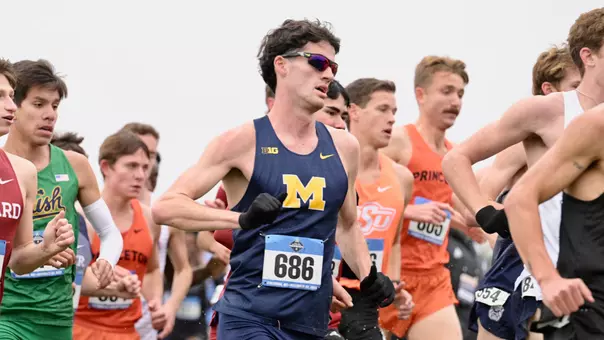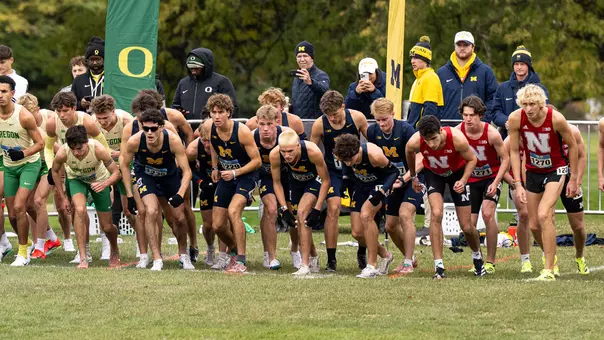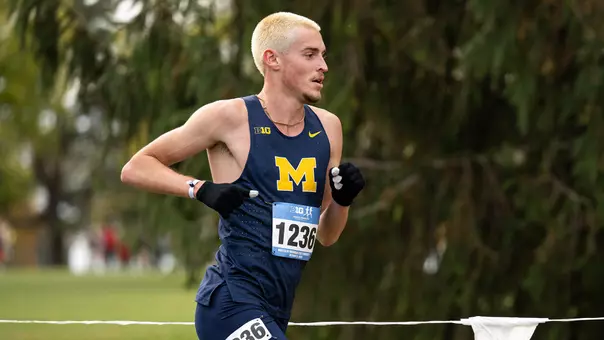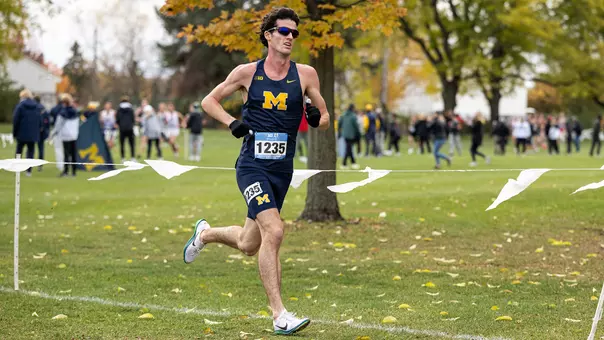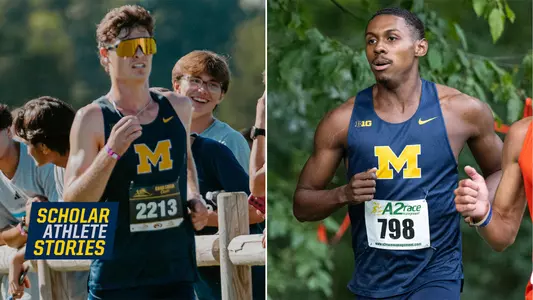
Scholar Stories: Hill, Brown Teammates on Course and in Kinesiology Lab
10/23/2025 10:00:00 AM | Men's Cross Country
Continuing the series that began in 2016-17, each week MGoBlue.com will highlight a Michigan student-athlete and their academic pursuits. These are our Scholar-Athlete Stories.
By: Jonathan Franchi
Teammates are so integral to team success. Great stories are told about the tight relationships between teammates on the field or on the court, but rare are stories about teammates who also make an impact in the classroom together.
Miles Brown and Ian Hill are members of the University of Michigan men's cross country team. Brown is a graduate student from Novi, Mich., who specializes in middle-distance races such as the 400- and 800-meter runs, while Hill is a senior from Spring Lake, Mich., who focuses on longer-distance running. The two have enjoyed success as teammates in their cross country careers, but they have made positive contributions together outside of their sport as well. Both working toward going to medical school and pursuing careers in medicine, they were able to jointly work on the setup, design and implementation of the Human Performance and Sport Science Center Athlete Innovation Lab at Michigan.
"We definitely helped with setting stuff up and organizing things, more foundational things like that," Hill said. "But, we also had opportunities to do research on our own and come back and report what we learned about different sports and what tests could be helpful. We learned what information to assess, like either new equipment to bring into the lab, or how we can develop a test protocol in order to be specific for that sport to maximize the data that we're getting. So, a lot of what we were doing was looking at the different sports at the university, especially the sports that would be interested in doing some testing in this lab, and identifying what tests we could do that could be predictive of performance or injury prevention or whatever that sport would want."
Competing in a physically strenuous sport at such a high level, Brown and Hill were interested in their fields due to their athletic career in cross country and track and field. With Brown's goal set on becoming a physician after medical school, he wanted a major that would focus on his interest in physiology in the scope of exercise, leading him to become an movement science student in the School of Kinesiology.
"I really enjoy the musculoskeletal portion of human physiology, and what I didn't know when I was applying was that there is also some neural stuff that you go over in the curriculum," Brown said. "But as a major, I like the fact that it was through the lens of exercise. Physiology made it so I was studying a subject in a realm I actually could see myself using in the future. At the time, I wasn't exactly sure whether I wanted to be a doctor, or maybe a physical therapist or something of that nature. But, I knew I wanted to be in that human-centered clinical space."
With such ambitions outside of athletics, Brown has accomplished a lot in cross country and track and field as well. During his five years representing the Maize and Blue, he has become the program record holder in the 600-meter run with a time of 1:15.87. He was also a second team All-American in 2022 for the indoor and outdoor 800-meter race and has been a part of multiple distance medley relay teams that have reached All-America status.
Originally a soccer player, Brown realized his potential in running after winning his first state championship as a sophomore in high school. He became aware of the unique mental aspects that come with running and enjoys the individual mindset to always improve.
"In my eyes, to win in the NCAA, you have to have everybody on your team firing on all cylinders, but in terms of your own performance, the things that you do on a day-to-day basis -- the way you sleep, the way you eat, the way you train, the way you recover -- a lot of that is indicative of how you perform at the end of the day," Brown said. "I think sometimes it's good to have a sport that's mental. Track and cross country are very physically-enduring, but they are also very mental."

Brown has always pushed himself to be the best in his sport, but he has also done the same outside of athletics. In addition to assisting with the HPSSC Athlete Innovation Lab, he also helped with the creation of the Movement and Applied Exercise Science program. This program is designed for early undergraduate students to complete a shortened semester where they get introduced to sports science careers or sports careers related to kinesiology. Brown helped by setting up the connections between the departments, such as sports psychology, sports nutrition, strength and conditioning, and athletic training, allowing younger students to get exposed to those fields and discover different career opportunities.
Brown discussed the guidance of Dr. Ken Kozloff, a Michigan track alum who aided in the design of the HPSSC Athlete Innovation Lab.
"We basically worked on setting up that lab so the future students and student-athletes could get hands-on experience and learn the different ideas of working in an exercise physiology lab," he said. "The lab is designed to actually be able to get usable and informative data for the coaching staff of the U of M athletics teams. It's in the basement of the Performance Center, and in the summer, we basically set up all the logistics of it, learned how to run the tests, and then in the past couple months now, there have been students in kinesiology that have come in, and I've helped teach them about some of the stuff. That part is pretty cool, being able to teach the students, a lot of them will learn the stuff that Ian and I did and understand it immediately. So, it's pretty awesome to see that. I think that it was Dr. Kozloff's mission to basically make a working lab that is going to eventually help with research publications, as well as a setup for students to understand how a sports science lab works."
Assisting with the lab has given Brown a unique experience in a field he is interested in while working alongside a fellow teammate outside of their sport.
Similar to Brown, Hill is following a closely related trajectory. Hill is a Biology, Health, and Society major, stemming from his natural interest in the sciences. Hill's father is a physician, and the senior from Spring Lake, Mich., plans on going to medical school after graduation from Michigan. While he is not certain what specific field he would like to pursue, Hill is definitely interested in sports medicine, and he got great experience helping with the setup of the lab.
"It was a phenomenal experience. I just learned a ton. I learned a lot about different metabolic testing, some of the biomechanics of running. All summer, I was just taking notes and going home and doing research, and that was what I wanted," Hill said. "It was cool to be a part of that process because I think this lab is really going to take off and change a lot of the ways that we assess athletes. Just being part of that process of coming up with protocols and helping things get situated -- especially for the interns that are now working there -- was really cool. And I can't wait to see how it starts to take off. I feel like I kind of got a firsthand look of what the capabilities are and what the future could look like, and it's pretty exciting."

Looking at some of the specific testing that was conducted over the summer, Hill recalled studying VO2 Max Testing, which tests someone's aerobic engine, identifying how much oxygen they can take in. Additionally, he looked at inertial measurement units, which give a three-dimensional image of the kinematics of motion, offering the ability to assess the different angles of someone's joints as they land on the ground. These are two of the many tests that can be used in the HPSSC Athlete Innovation Lab to help improve performance across Michigan Athletics.
In addition to his work in the HPSSC Athlete Innovation Lab, Hill performed volunteer work at a cardiac rehabilitation center for outpatients from the University of Michigan Hospital. This was essentially a gym for those who had undergone cardiac procedures, such as a stent or open-heart surgery, to monitor their heart rate and blood pressure while they worked out. The patients also performed different EKG tests while working out to monitor and improve their heart function while they worked out. Hill is grateful for his experience there and made many connections that gave him meaningful advice about the industry.
Outside of the classroom, Hill is off to a great start to begin his senior cross country campaign, posting a career-best time of 15:12.8 at the five-kilometer distance race for a 12th-place finish at the Michigan Open. He takes part in the five- and eight-kilometer races in cross country, while also competing in longer-distance track and field events.
Hill and Brown have developed a special relationship athletically and academically, strengthened by the opportunity to work together on the HPSSC Athlete Innovation Lab.
"Miles is a really good friend of mine. I feel like I'm pretty close to him now, especially working over the summer with him. But, I mean, it was awesome. Miles is such a good dude, and I had a blast working with him; definitely never a dull moment," he said. "But Miles, particularly, he's a guy I look up to as a year older than me, and he's on a very similar route as well. He's pre-med, and he's working on his applications right now. So, I feel like I asked him a lot of questions about his process and his experiences, and he's been a great guy to lean on for information and for help, kind of guiding my path."
Being able to contribute to the overall execution of the HPSSC Athlete Innovation Lab has been a special opportunity for Brown and Hill, allowing them to learn more about the sports science field while also contributing to the betterment and future of the performance of Michigan athletes and teams. With both planning to attend medical school, this work will better prepare them for their futures. Whether it was on the cross country course or in the HPSSC, Brown and Hill have made significant strides at Michigan, working together to create an impact that will last for years to come.

